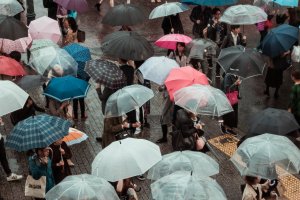Every year, 20 to 30 typhoons of varying sizes affect Japan. Some of these may never reach the coast to make a lasting impact but several can cause flash rain, floods, and structural damage. Unfortunately, every year typhoon season catches many unprepared.
It’s important to know what to expect, take sensible precautions—and above all—remain calm. Most typhoons pass without major incident and monitoring news sources can keep you informed.
Instead of giving the typhoons specific names, they are referred to by number (i.e. the 16th typhoon of the year is “Typhoon Number 16”) in Japanese media. Western Japan tends to suffer more damage from typhoons than the east coast. Typhoons almost always travel northeast, starting with Okinawa; thus, the Ryukyu Islands are heavily affected during the annual typhoon season. Although the number of typhoon-related casualties has decreased steadily in recent years thanks to sturdier buildings, however, it goes without saying that they can still cause damage and claim lives.
When do typhoons occur?
Typhoon season typically lasts from May to October, with August and September being peak months. It just also so happens to be one of the best times to visit Japan with so many festivals and events going on. If you’re staying in Japan during the typhoon season, it’s important that you know how to get accurate information and stay alert.

How typhoons affect travel
Don't take warnings and typhoon news lightly. It might be an annoyance when your vacation is interrupted by a typhoon but you’ll be happier when you come out the other side, safe and dry. Aside from torrential rainfall and strong winds, the following can be typical before, during, and even after the typhoon makes landfall.
- Flights may be delayed, rerouted, or canceled.
- Train and bus services may be delayed or canceled.
- Businesses, including major theme parks, museums, shrines, and temples may shorten hours or close temporarily.
- Affected areas may endure power or water service interruptions.
- Roads may be blocked by debris and closed to traffic.
- Flooding may occur.
- There may be typhoon sirens that call for evacuation (covered later).
Preparing for a typhoon
Preparation is important during any natural disaster, and typhoons are just the same. Keep a level head and start preparing as soon as the typhoon is announced. Many stores and conbini will sell out of food (bread is usually the first the go) so you’ll want to stock up fast. Make a checklist based on the items below and you’ll be ready in no time.
- Check the weather before visiting Japan and during your stay.
- If a typhoon is moving toward you, make sure you know the proper evacuation area (hinanjo 避難所).
- Prepare an emergency kit. It may sound complicated but think small: non-perishable food, emergency numbers, a flashlight/torch and batteries, other mobile necessities.
- Charge all electronics in case of a power outage—this not only keeps you up-to-date but gives you something to pass the time with. (cell phones, iPads, mobile gaming devices, Kindles, etc.)
- Keep your passport, airline tickets, cash, credit cards, and other documents in a waterproof, sealed bag.
- Water! Have it in bottles (fill them up if you have spares). And residents can consider filling the bathtub.
- Residents: Bring in outdoor objects that could be blown away and secure larger objects—bicycles, laundry poles, etc.
- Residents: Close storm shutters if available.

During a typhoon
The typhoon has arrived. Stay calm. Don’t panic. Here are some simple tips to keep you and your loved ones safe.
- Get the emergency kit you prepared somewhere accessible and ready to go.
- If you’re in the path of a typhoon, wear clothing to bed that you can go outside in.
- Avoid sleeping near windows.
- Do not go outside to take photos of the storm.
- Avoid coastal areas and river banks; these areas are likely to suffer flooding and may even experience a tsunami.
- If you’re in a place vulnerable to flooding, stay on the second floor.
- Stay up to date with typhoon advisories from the Japan Meteorological Agency.
- Stay away from downed power lines.
- With high winds, umbrellas are more of a hazard than a help.
- Stay indoors if you can; public transportation is likely to shut down or suffer terrible delays.
In case of evacuation
If you’re staying at accommodation lodging, chances are that someone will brief you or staff will guide you in case of an evacuation. If, however, you’re staying on your own or a friend’s house, you may need to know the evacuation process.
“Evacuation” in Japanese is “hinan” (避難). Often loudspeakers in the area will announce whether or not it’s necessary. The only problem is that these announcements are in Japanese and even then, they can be difficult to understand due to outside noise and the delay between words. Also note, pets are not allowed at most evacuation centers.
It can still be difficult to know if your area is evacuating, though a great tool (assuming you’ve charged your cellphone) is emergency apps, such as Safety Tips (Android/ iOS) which can be set to display hazard and evacuation information in English, Korean, and Chinese (simplified and traditional).
Covid-19 and evacuation
The Covid-19 pandemic has created a new norm dictated by increased hygiene and social distancing. In the case of a tsunami evacuation, these protocols may not be possible and it is important to follow instructions as you normally would.
Emergency evacuation orders always take precedence over Covid-19 requirements to stay home.
Be prepared with a “grab bag” filled with hand sanitizer, disposable tissues, disinfectant wipes, and face masks, and while evacuating, avoid direct contact with others, socially distance, and sneeze/cough into disposable tissues whenever possible.
Other useful apps include:
- Hurricane and Typhoon Track Pro (iPhone) – Shows the path of typhoons and expected affected areas, as well as a survival guide
- Typhoon Tracker (Android) – Provides information on location and intensity of typhoons in the Asian Pacific
- X (formerly Twitter) (Android / iPhone / Windows Phone)—Not just useful for letting your followers know you are okay, a number of organizations also support Twitter Alerts, allowing them to push crisis information to subscribers in real-time. Currently, these services are only available in Japanese.
Emergency numbers and channels
It’s important to know who to call in an emergency. Here’s a simple list of emergency numbers and more details, should you need them.
- 119—You can call this number in case of a fire or if you are in need of an ambulance/rescue service.
- 03 3201 3331—This is the number to Japan National Tourism Organization’s Tourist Information Center.
- 03 3580 3311—This is the number to call to get in touch with the Ministry of Foreign Affairs.
- On television, NHK (Channel 1) is Japan’s national public broadcasting organization and provides news at the top of every hour. NHK Radio 1 can be accessed at 594 AM. Download the NHK World app for live news with multilingual translations. Through the app you can enable tsunami and earthquake push notifications.
- The weather forecast and weather information can be heard by dialing 177 on the phone (in Japanese only).
- The MegaNet is Japan’s only network of multilingual radio stations, serving 10 languages (English, Japanese, Korean, Chinese, Tagalog, Thai, Bahasa Indonesia, Spanish, Portuguese, and French) and broadcasting public service announcements in all of them. The MegaNet stations are:
- InterFM (Kanto Area)—89.7 FM, 76.5 FM for Kanagawa
- InterFM Nagoya (Nagoya & surrounding areas)—79.5 FM
- FM Cocolo (Osaka, Hyogo, Kyoto, Nara)—76.5 FM
- Love FM (Fukuoka & Saga)—76.1 FM, 82.5 FM for western Fukuoka, 82.7 FM for Kita-Kyushu

Emergency supplies
Here’s a simple list of items you may find yourself in need of:
- Radio
- Water
- Bread and non-perishable food
- Flashlight/ torch
- Raincoat
- Rain boots with a drawstring top
- Towel
- First-aid kit
- Batteries
- Charger/ portable charger
- Toilet Paper
- Trash bags (Can double as a rain poncho in a pinch)
- Prescription and non-prescription medications
- Duct tape
- Face masks and hand sanitizer





























